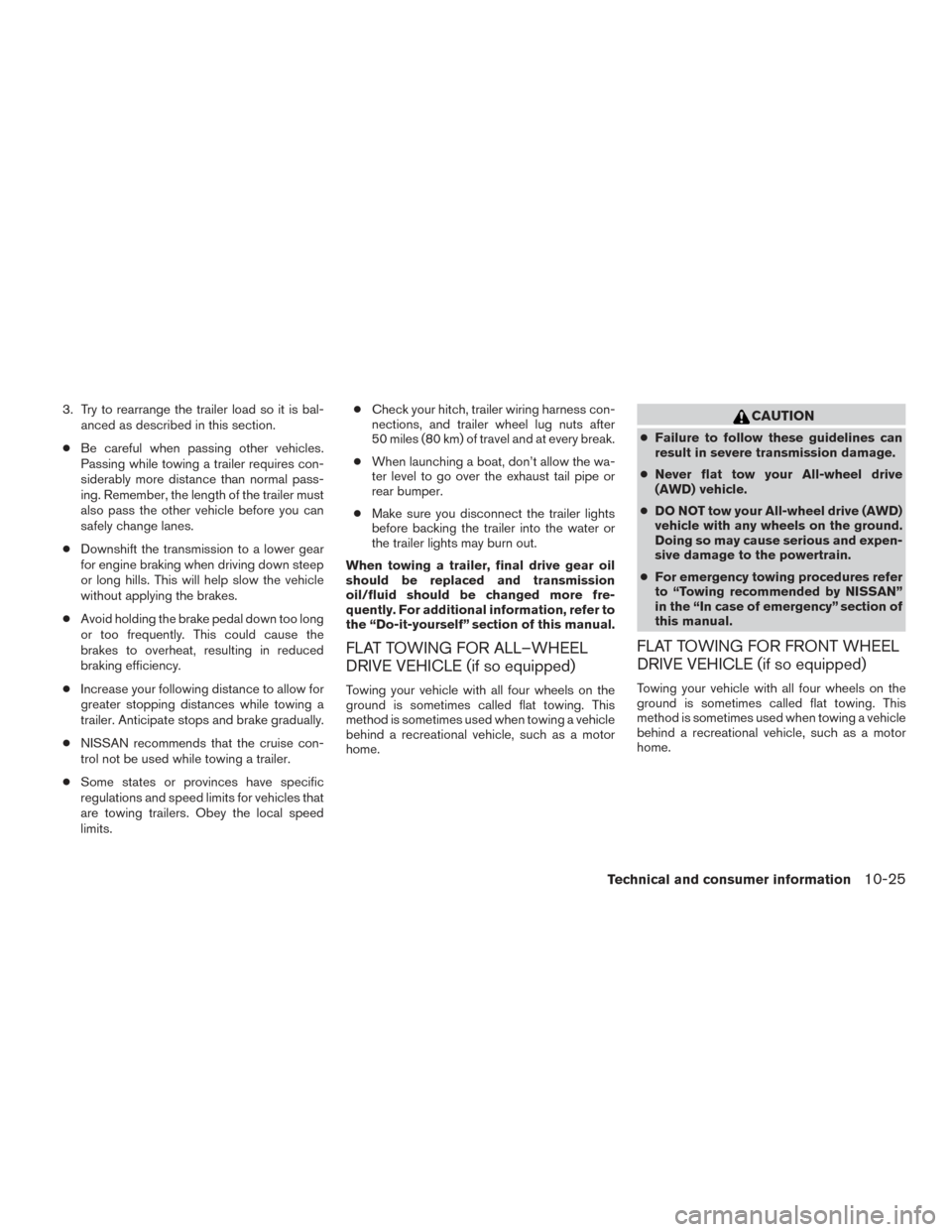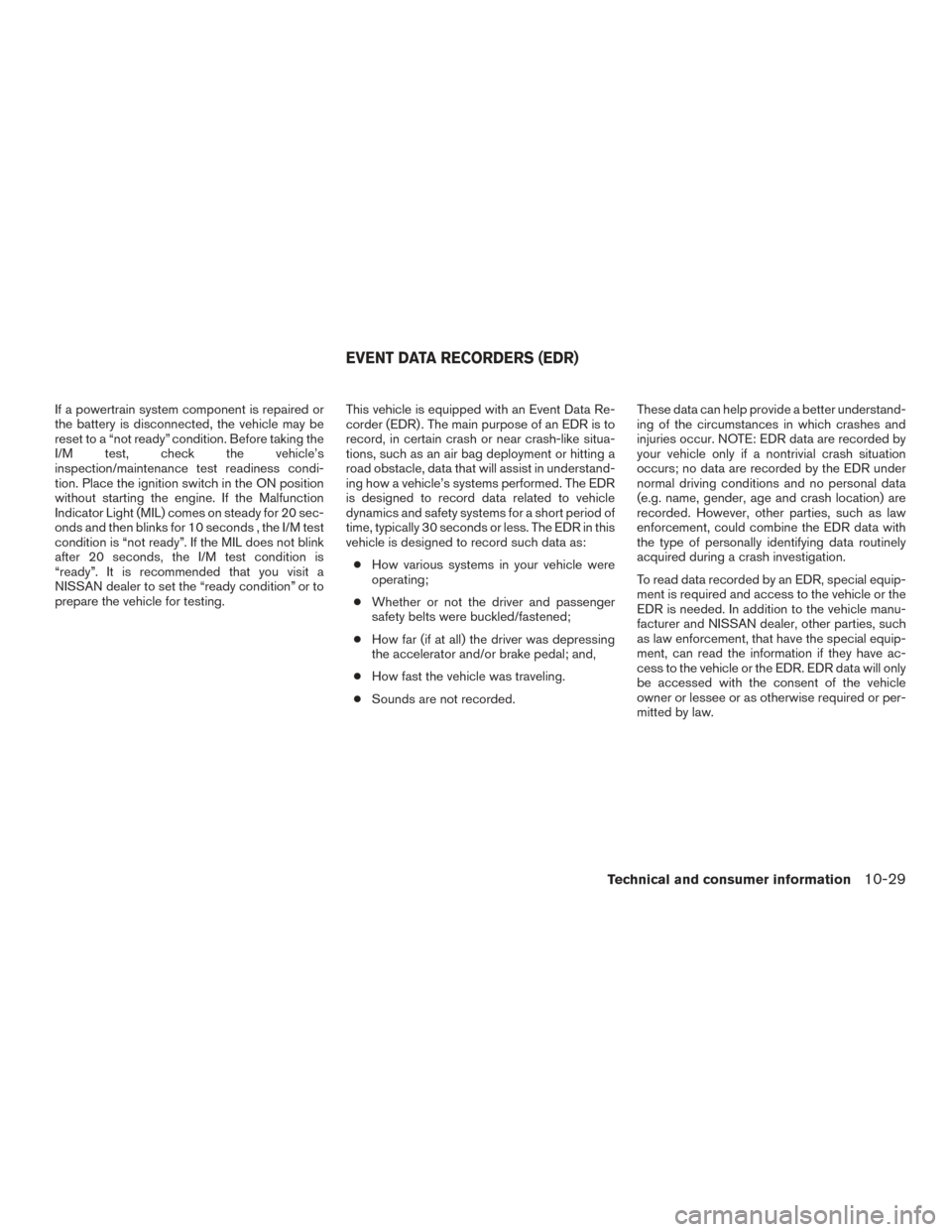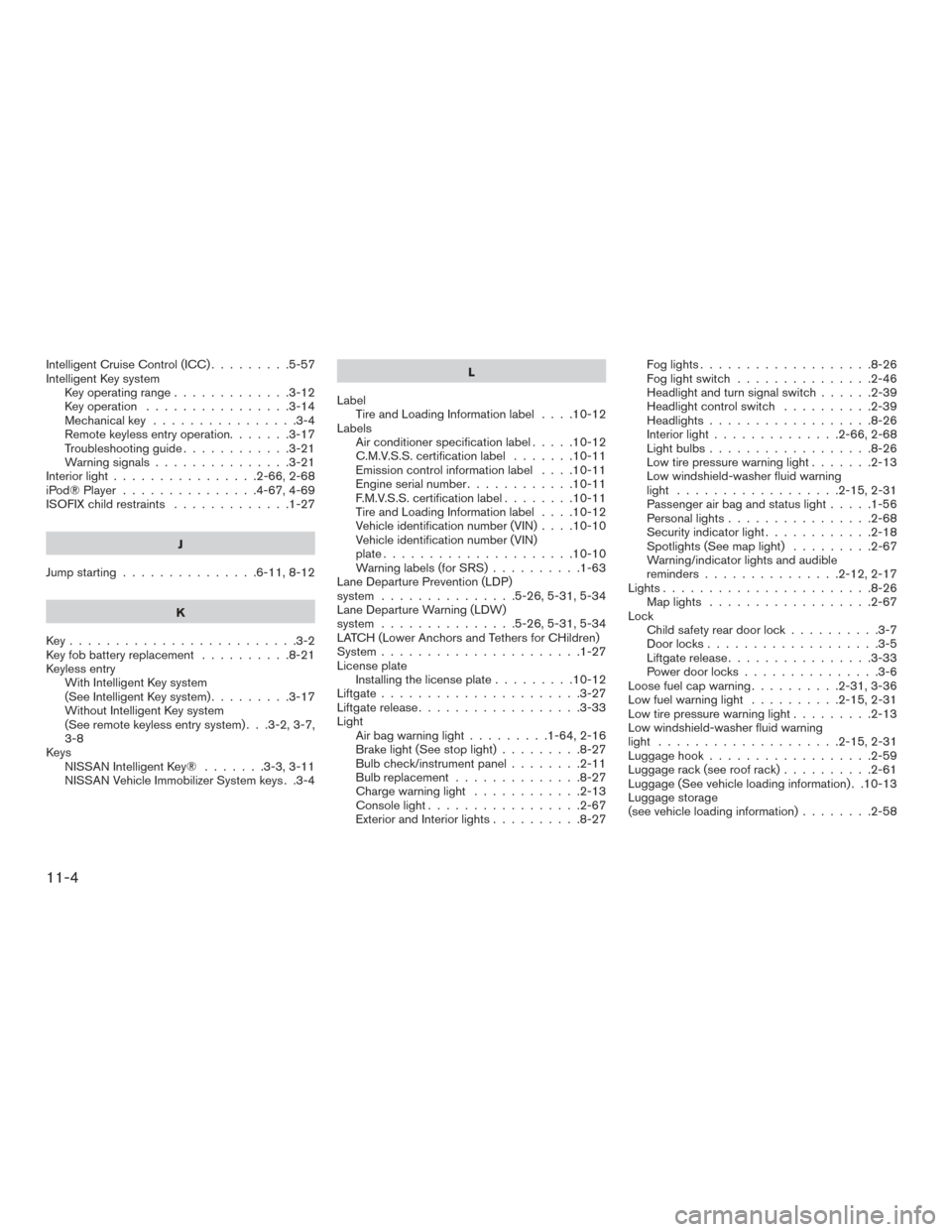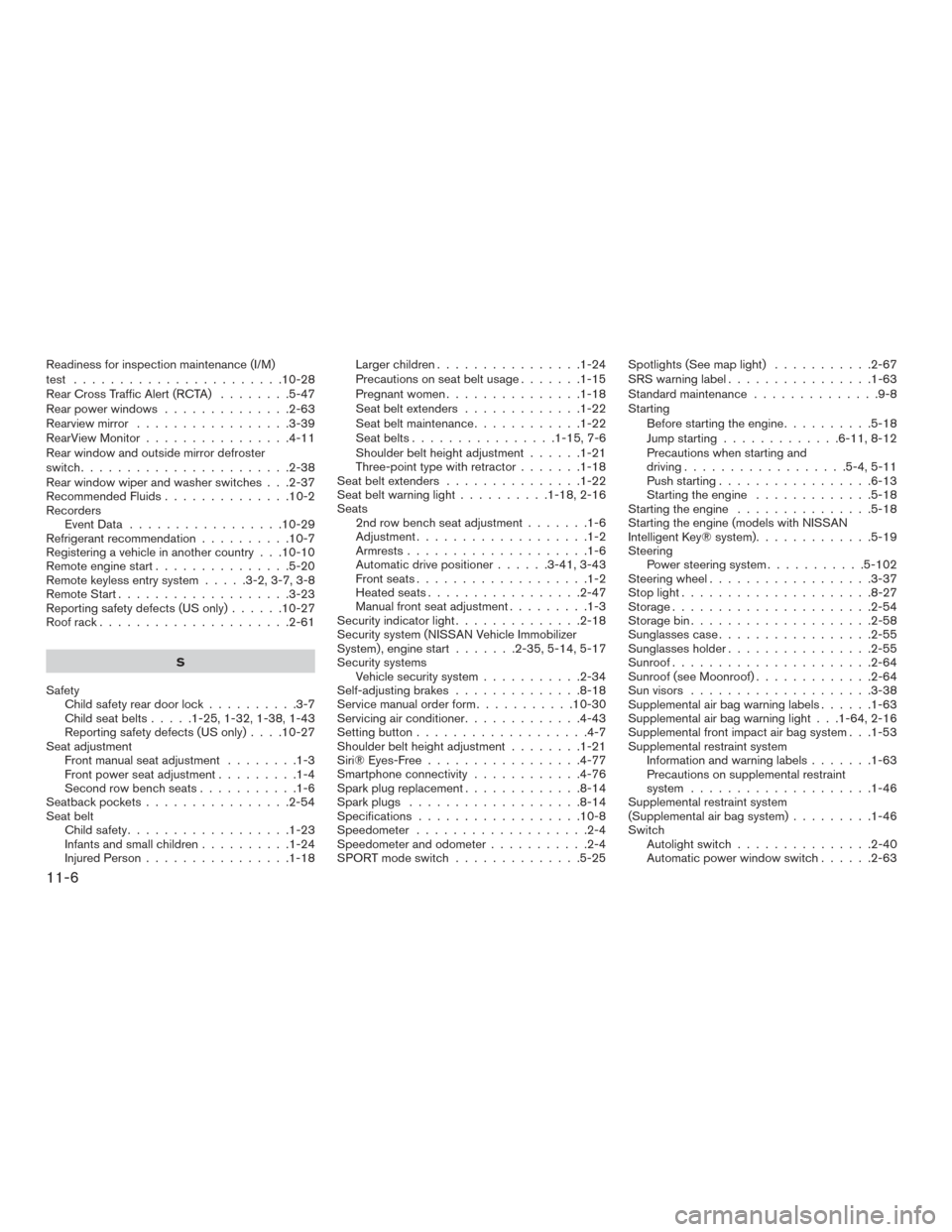2017 NISSAN ROGUE brake
[x] Cancel search: brakePage 531 of 547

Always block the wheels on both vehicle and
trailer when parking. Parking on a slope is not
recommended; however, if you must do so:
CAUTION
If you move the shift lever to the P (Park)
position before blocking the wheels and
applying the parking brake, transmission
damage could occur.1. Apply and hold the brake pedal.
2. Have someone place blocks on the downhill side of the vehicle and trailer wheels.
3. After the wheel blocks are in place, slowly release the brake pedal until the blocks ab-
sorb the vehicle load.
4. Apply the parking brake.
5. Shift the transmission into P (Park) .
6. Turn off the engine.
To drive away: 1. Start the vehicle.
2. Apply and hold the brake pedal.
3. Shift the transmission into gear.
4. Release the parking brake. 5. Drive slowly until the vehicle and trailer are
clear from the blocks.
6. Apply and hold the brake pedal.
7. Have someone retrieve and store the blocks. ● While going downhill, the weight of the
trailer pushing on the tow vehicle may de-
crease overall stability. Therefore, to main-
tain adequate control, reduce your speed
and shift to a lower gear. Avoid long or
repeated use of the brakes when descend-
ing a hill, as this reduces their effectiveness
and could cause overheating. Shifting to a
lower gear instead provides “engine brak-
ing” and reduces the need to brake as fre-
quently.
● If the engine coolant temperature rises to a
high temperature, refer to “If your vehicle
overheats” in the “In case of emergency”
section of this owner’s manual.
● Trailer towing requires more fuel than normal
circumstances.
● Avoid towing a trailer for your vehicle’s first
500 miles (805 km) .
● For the first 500 miles (805 km) that you do
tow, do not drive over 50 mph (80 km/h). ●
Have your vehicle serviced more often than
at intervals specified in the recommended
Maintenance Schedule in the “Maintenance
and schedules” section of this manual.
● When making a turn, your trailer wheels will
be closer to the inside of the turn than your
vehicle wheels. To compensate for this,
make a larger than normal turning radius
during the turn.
● Crosswinds and rough roads will adversely
affect vehicle/trailer handling, possibly caus-
ing vehicle sway. When being passed by
larger vehicles, be prepared for possible
changes in crosswinds that could affect ve-
hicle handling.
Do the following if the trailer begins to sway: 1. Take your foot off the accelerator pedal to allow the vehicle to coast and steer as
straight ahead as the road conditions allow.
This combination will help stabilize the ve-
hicle
– Do not correct trailer sway by steering or applying the brakes.
2. When the trailer sway stops, gently apply the brakes and pull to the side of the road in a
safe area.
10-24Technical and consumer information
Page 532 of 547

3. Try to rearrange the trailer load so it is bal-anced as described in this section.
● Be careful when passing other vehicles.
Passing while towing a trailer requires con-
siderably more distance than normal pass-
ing. Remember, the length of the trailer must
also pass the other vehicle before you can
safely change lanes.
● Downshift the transmission to a lower gear
for engine braking when driving down steep
or long hills. This will help slow the vehicle
without applying the brakes.
● Avoid holding the brake pedal down too long
or too frequently. This could cause the
brakes to overheat, resulting in reduced
braking efficiency.
● Increase your following distance to allow for
greater stopping distances while towing a
trailer. Anticipate stops and brake gradually.
● NISSAN recommends that the cruise con-
trol not be used while towing a trailer.
● Some states or provinces have specific
regulations and speed limits for vehicles that
are towing trailers. Obey the local speed
limits. ●
Check your hitch, trailer wiring harness con-
nections, and trailer wheel lug nuts after
50 miles (80 km) of travel and at every break.
● When launching a boat, don’t allow the wa-
ter level to go over the exhaust tail pipe or
rear bumper.
● Make sure you disconnect the trailer lights
before backing the trailer into the water or
the trailer lights may burn out.
When towing a trailer, final drive gear oil
should be replaced and transmission
oil/fluid should be changed more fre-
quently. For additional information, refer to
the “Do-it-yourself” section of this manual.
FLAT TOWING FOR ALL–WHEEL
DRIVE VEHICLE (if so equipped)
Towing your vehicle with all four wheels on the
ground is sometimes called flat towing. This
method is sometimes used when towing a vehicle
behind a recreational vehicle, such as a motor
home.
CAUTION
● Failure to follow these guidelines can
result in severe transmission damage.
● Never flat tow your All-wheel drive
(AWD) vehicle.
● DO NOT tow your All-wheel drive (AWD)
vehicle with any wheels on the ground.
Doing so may cause serious and expen-
sive damage to the powertrain.
● For emergency towing procedures refer
to “Towing recommended by NISSAN”
in the “In case of emergency” section of
this manual.
FLAT TOWING FOR FRONT WHEEL
DRIVE VEHICLE (if so equipped)
Towing your vehicle with all four wheels on the
ground is sometimes called flat towing. This
method is sometimes used when towing a vehicle
behind a recreational vehicle, such as a motor
home.
Technical and consumer information10-25
Page 536 of 547

If a powertrain system component is repaired or
the battery is disconnected, the vehicle may be
reset to a “not ready” condition. Before taking the
I/M test, check the vehicle’s
inspection/maintenance test readiness condi-
tion. Place the ignition switch in the ON position
without starting the engine. If the Malfunction
Indicator Light (MIL) comes on steady for 20 sec-
onds and then blinks for 10 seconds , the I/M test
condition is “not ready”. If the MIL does not blink
after 20 seconds, the I/M test condition is
“ready”. It is recommended that you visit a
NISSAN dealer to set the “ready condition” or to
prepare the vehicle for testing.This vehicle is equipped with an Event Data Re-
corder (EDR) . The main purpose of an EDR is to
record, in certain crash or near crash-like situa-
tions, such as an air bag deployment or hitting a
road obstacle, data that will assist in understand-
ing how a vehicle’s systems performed. The EDR
is designed to record data related to vehicle
dynamics and safety systems for a short period of
time, typically 30 seconds or less. The EDR in this
vehicle is designed to record such data as:
● How various systems in your vehicle were
operating;
● Whether or not the driver and passenger
safety belts were buckled/fastened;
● How far (if at all) the driver was depressing
the accelerator and/or brake pedal; and,
● How fast the vehicle was traveling.
● Sounds are not recorded. These data can help provide a better understand-
ing of the circumstances in which crashes and
injuries occur. NOTE: EDR data are recorded by
your vehicle only if a nontrivial crash situation
occurs; no data are recorded by the EDR under
normal driving conditions and no personal data
(e.g. name, gender, age and crash location) are
recorded. However, other parties, such as law
enforcement, could combine the EDR data with
the type of personally identifying data routinely
acquired during a crash investigation.
To read data recorded by an EDR, special equip-
ment is required and access to the vehicle or the
EDR is needed. In addition to the vehicle manu-
facturer and NISSAN dealer, other parties, such
as law enforcement, that have the special equip-
ment, can read the information if they have ac-
cess to the vehicle or the EDR. EDR data will only
be accessed with the consent of the vehicle
owner or lessee or as otherwise required or per-
mitted by law.
EVENT DATA RECORDERS (EDR)
Technical and consumer information10-29
Page 538 of 547

11 Index
2nd row bench seat adjustment.........1-6
A
Aiming control, headlights ........2-43,2-44
Air bag (See supplemental restraint
system) .....................1-46
Air bag system Front (See supplemental front impact
air bag system) ...............1-53
Airbagwarninglabels.............1-63
Airbagwarninglight...........1-64,2-16
Air bag warning light, supplemental . .1-64, 2-16
Air cleaner housing filter ............8-15
Air conditioner Air conditioner operation ..........4-35
Air conditioner specification label ....10-12
Air conditioner system refrigerant and
oil recommendations ............10-7
Air conditioner system refrigerant
recommendations ..............10-7
Heater and air conditioner
controls................4-33,4-41
Servicing air conditioner ..........4-43
Airflowcharts..................4-37
Alarm system
(See vehicle security system) .........2-34
All-Wheel Drive .................5-98
Anchor point locations .............1-30
Antenna .....................4-76
Antifreeze ...................5-111
Anti-lock brake warning light ..........2-12Anti-lock Braking System (ABS)
.......5-103
Apps .......................4-76
Armrests .....................1-6
AroundView®Monitor.............4-17
Audible reminders ...............2-19
Audio system ..................4-43
AMradioreception.............4-44
Bluetooth®audio..........4-72,4-73
Bluetooth® streaming audio ....4-72,4-73
Compact disc (CD) player .....4-55,4-62
FM/AM/SAT radio with compact disc (CD)
player.................4-52,4-57
FMradioreception.............4-44
iPod® Player .............4-67,4-69
iPod® player operation .......4-67,4-69
Radio ....................4-43
USB interface ............4-63,4-65
USB (Universal Serial Bus) Connection
Port..................4-63,4-65
Autolight switch .................2-40
Automatic Automatic drive positioner .....3-41,3-43
Automatic power window switch .....2-63
Automatic anti-glare inside mirror .......3-39
Automatic door locks ..............3-7
Automatic drive positioner .......3-41,3-43
AUXjack ....................4-63
AWD.......................5-98
B
Battery .................5- 111, 8-11Charge warning light
............2-13
Battery replacement ..............8-21
Keyfob ...................8-21
NISSAN Intelligent Key® ......8-23,8-24
Before starting the engine ...........5-18
Belt (See drive belt) ..............8-13
Blind Spot Warning (BSW) warning
system......................5-37
Bluetooth® audio ............4-72,4-73
Bluetooth® hands-free phone
system..................4-81,4-94
Bluetooth® streaming audio with Navigation
System .....................4-73
Boosterseats..................1-43
Brake Anti-lock Braking System (ABS) .....5-103
Brake fluid ..................8-9
Brakelight(Seestoplight).........8-27
Brake system ...............5-103
Brakewarninglight.............2-12
Brakewearindicators........2-19,8-18
Parking brake operation ..........5-25
Self-adjusting brakes ............8-18
Brake assist ..................5-104
Brake fluid ....................8-9
Brakes ......................
8-18
Brake system .................5-103
Break-inschedule ...............5-96
Brightness/contrast button ...........4-10
Brightness control Instrument panel ..............2-45
Bulb check/instrument panel ..........2-11
Bulbreplacement................8-27
Page 540 of 547

Engine coolant temperature gauge.......2-6
Enterbutton....................4-4
Event Data recorders .............10-29
Exhaust gas (Carbon monoxide) .........5-4
Explanation of maintenance items ........9-2
Explanation of scheduled maintenance items . .9-5
Extendedstorageswitch ............2-53
Eyeglass case ..................2-55
F
Flashers (See hazard warning flasher switch) . .6-2
Flat tire .......................6-3
Floor mat positioning aid .............7-5
Fluid Brake fluid ...................8-9
Capacities and recommended
fuel/lubricants ................10-2
Continuously Variable Transmission (CVT)
fluid.......................8-9
Engine coolant .................8-4
Engine oil ...................8-6
Windshield-washerfluid...........8-10
F.M.V.S.S. certification label ..........10-11
Foglightswitch .................2-46
Forward Emergency Braking (FEB) .......2-13
Forward Emergency Braking (FEB) with
Pedestrian Detection system ..........5-87
Front air bag system
(See supplemental restraint system) ......1-53
Front power seat adjustment ...........1-4
Frontseats.....................1-2
Fuel Capacities and recommended
fuel/lubricants ................10-2 Fuel economy
................5-98
Fuel-filler door and cap ...........3-35
Fuel gauge ...................2-7
Fuel octane rating ..............10-5
Fuel recommendation ............10-4
Loose fuel cap warning ...........2-31
Fuel efficient driving tips .............5-96
Fuel-filler door ...............3-34,3-34
Fuelgauge.....................2-7
Fuses.......................8-18
Fusiblelinks ...................8-19
G
Garage door opener, HomeLink® Universal
Transceiver ......2-69,2-70,2-71,2-72,2-72
Gascap .....................3-35
Gauge Engine coolant temperature gauge .....2-6
Fuel gauge ...................2-7
Odometer ...................2-5
Speedometer .................2-4
Tachometer ..................2-6
Trip odometer .................2-5
General maintenance ...............9-2
Glovebox.....................2-54
H
Hands-free phone system,
Bluetooth®................4-81,4-94
Hazard warning flasher switch ..........6-2
Headlight aiming control .........2-43,2-44
Headlight and turn signal switch ........2-39Headlightcontrolswitch ............2-39
Headlights....................8-26
Headlights, aiming control
........2-43,2-44
Head restraints ..................1-10
Heated seats ...................2-47
Heated steering wheel switch .........2-48
Heater Heater and air conditioner
controls ................4-33,4-41
Heater operation ...........4-34,4-42
Hill start assist system .............5-110
HomeLink® Universal
Transceiver......2-69,2-70,2-71,2-72,2-72
H
ood.......................3-26
Hook Luggage hook ................2-59
Horn .......................2-46
I
Ignition switch ..................5-13
Ignition Switch Push-Button Ignition Switch ........5-14
Immobilizer system .........2-35,5-14,5-17
Important vehicle information label ......10-11
In-cabin microfilter ................8-15
Increasing fuel economy .............5-98
Indicator lights and audible reminders
(See warning/indicator lights and audible
reminders).................2-12,2-17
Information display ................2-20
Inside automatic anti-glare mirror ........3-39
Instrument brightness control ..........2-45
Instrumentpanel...............0-6,2-2
Instrument panel dimmer switch ........2-45
11-3
Page 541 of 547

Intelligent Cruise Control (ICC).........5-57
Intelligent Key system Key operating range .............3-12
Key operation ................3-14
Mechanicalkey ................3-4
Remote keyless entry operation.......3-17
Troubleshooting guide ............3-21
Warning signals ...............3-21
Interiorlight................2-66,2-68
iPod®Player ...............4-67,4-69
ISOFIX child restraints .............1-27
J
Jump starting ...............6-11,8-12
K
Key.........................3-2
Key fob battery replacement ..........8-21
Keyless entry With Intelligent Key system
(See Intelligent Key system) .........3-17
Without Intelligent Key system
(See remote keyless entry system) . . .3-2, 3-7,
3-8
Keys NISSAN Intelligent Key® .......3-3,3-11
NISSAN Vehicle Immobilizer System keys . .3-4 L
Label Tire and Loading Information label ....10-12
Labels Air conditioner specification label .....10-12
C.M.V.S.S. certification label .......10-11
Emission control information label ....10-11
Engine serial number ............10-11
F.M.V.S.S. certification label ........10-11
Tire and Loading Information label ....10-12
Vehicle identification number (VIN) ....10-10
Vehicle identification number (VIN)
plate.....................10-10
Warning labels (for SRS) ..........1-63
Lane Departure Prevention (LDP)
system ...............5-26,5-31,5-34
Lane Departure Warning (LDW)
system ...............5-26,5-31,5-34
LATCH (Lower Anchors and Tethers for CHildren)
System ......................1-27
License plate Installing the license plate .........10-12
Liftgate ......................3-27
Liftgate release ..................3-33
Light Air bag warning light .........1-64,2-16
Brake light (See stop light) .........8-27
Bulb check/instrument panel ........2-11
Bulbreplacement..............8-27
Charge warning light ............2-13
Consolelight.................2-67
Exterior and Interior lights ..........8-27 Foglights...................8-26
Fog light switch
...............2-46
Headlightandturnsignalswitch......2-39
Headlight control switch ..........2-39
Headlights..................8-26
Interiorlight..............2-66,2-68
Lightbulbs..................8-26
Low tire pressure warning light .......2-13
Low windshield-washer fluid warning
light ..................2-15,2-31
Passenger air bag and status light .....1-56
Personal lights ................2-68
Security indicator light ............2-18
Spotlights(Seemaplight) .........2-67
Warning/indicator lights and audible
reminders ...............2-12,2-17
Lights.......................8-26 Maplights ..................2-67
Lock Child safety rear door lock ..........3-7
Door locks ...................3-5
Liftgate release ................3-33
Power door locks ...............3-6
Loose
fuel cap warning ..........2-31,3-36
Low fuel warning light ..........2-15,2-31
Low tire pressure warning light .........2-13
Low windshield-washer fluid warning
light ....................2-15,2-31
Luggage hook ..................2-59
Luggage rack (see roof rack) ..........2-61
Luggage (See vehicle loading information) . .10-13
Luggage storage
(see vehicle loading information) ........2-58
11-4
Page 542 of 547

M
Maintenance General maintenance .............9-2
Insidethevehicle...............9-3
Maintenance precautions ...........8-2
Outside the vehicle ..............9-2
Seat belt maintenance ............1-22
Under the hood and vehicle .........9-4
Maintenance log .................9-13
Maintenance requirements ............9-2
Maintenance schedules ..............9-7
Maintenance under severe operation
conditions ....................9-12
Malfunction indicator light ............2-17
Manual front seat adjustment ...........1-3
Maplights ....................2-67
Memory Seat ...............3-41,3-43
Meters and gauges ................2-4
Instrument brightness control ........2-45
Mirror Automatic anti-glare inside mirror ......3-39
Outside mirrors ...............3-40
Rearview ...................3-39
Vanity mirror .................3-38
Mirrors ......................3-39
Mobileapps ...................4-76
Moonroof .....................2-64
Moving Object Detection (MOD) ........4-28
N
NissanConnect
SM................4-76
NissanConnectSMServices...........4-77 NISSAN Intelligent Key®
.........3-3,3-11
NISSAN Vehicle Immobilizer
System ...............2-35,5-14,5-17
NISSAN voice recognition system ......4-103
O
Octane rating (See fuel octane rating) .....10-5
Odometer .....................2-5
Oil Capacities and recommended
fuel/lubricants ................10-2
Changingengineoil..............8-7
Changing engine oil filter ...........8-8
Checking engine oil level ...........8-6
Engine oil ...................8-6
Engine oil and oil filter recommendation . .10-6
Engine oil viscosity ..............10-7
Oneshotcall............4-84,4-84,4-96
Outside mirrors .................3-40
Overhead sunglasses holder ..........2-55
Overheat If your vehicle overheats ...........6-13
Owner’s manual order form ..........10-30
Owner’s manual/service manual order
information ...................10-30
P
Parking Parking brake operation ...........5-25
Parking/parking on hills ..........5-102
Parking brake ...................5-25
Personallights..................2-68 Phone, Bluetooth® hands-free
system
...................4-81,4-94
Power Front seat adjustment .............1-4
Powerdoorlocks...............3-6
Power outlet .................2-51
Power rear windows .............2-63
Power steering system ...........5-102
Power windows ...............2-62
Rear power windows ............2-63
Power outlet ...................2-51
Power steering .................5-102
Precautions Maintenance precautions ...........8-2
On-pavement and off-road driving
precautions ..................5-9
Precautions on booster
seats ...........1-25,1-32,1-38,1-43
Precautions on child
restraints .........1-25,1-32,1-38,1-43
Precautions on seat belt usage .......1-15
Precautions on supplemental restraint
system ....................1-46
Precautions when starting and
driving ..................5-4,5-11
Programmable features ..............4-7
Push starting ...................6-13
R
Radio CarphoneorCBradio ...........4-81
FM/AM/SAT radio with compact disc (CD)
player .................4-52,4-57
11-5
Page 543 of 547

Readiness for inspection maintenance (I/M)
test .......................10-28
Rear Cross Traffic Alert (RCTA)........5-47
Rear power windows ..............2-63
Rearview mirror .................3-39
RearViewMonitor................4-11
Rear window and outside mirror defroster
switch .......................2-38
Rear window wiper and washer switches . . .2-37
Recommended Fluids ..............10-2
Recorders EventData .................10-29
Refrigerant recommendation ..........10-7
Registering a vehicle in another country . . .10-10
Remote engine start ...............5-20
Remote keyless entry system .....3-2,3-7,3-8
Remote Start ...................3-23
Reporting safety defects (US only) ......10-27
Roof rack .....................2-61
S
Safety Child safety rear door lock ..........3-7
Childseatbelts.....1-25,1-32,1-38,1-43
Reporting safety defects (US only) ....10-27
Seat adjustment Front manual seat adjustment ........1-3
Front power seat adjustment .........1-4
Second row bench seats ...........1-6
Seatback pockets ................2-54
Seat belt Childsafety..................1-23
Infantsandsmallchildren..........1-24
Injured Person ................1-18 Larger children
................1-24
Precautions on seat belt usage .......1-15
Pregnant women ...............1-18
Seat belt extenders .............1-22
Seatbeltmaintenance............1-22
Seatbelts................1-15,7-6
Shoulder belt height adjustment ......1-21
Three-point type with retractor .......1-18
Seatbeltextenders ...............1-22
Seat belt warning light ..........1-18,2-16
Seats 2nd row bench seat adjustment .......1-6
Adjustment...................1-2
Armrests ....................1-6
Automatic drive positioner ......3-41,3-43
Frontseats...................1-2
Heatedseats.................2-47
Manual front seat adjustment .........1-3
Security indicator light ..............2-18
Security system (NISSAN Vehicle Immobilizer
System) , engine start .......2-35,5-14,5-17
Security systems Vehicle security system ...........2-34
Self-adjusting brakes ..............8-18
Service manual order form ...........10-30
Servicing air conditioner .............4-43
Setting button ...................4-7
Shoulder belt height adjustment ........1-21
Siri® Eyes-Free .................4-77
Smartphone connectivity ............4-76
Sparkplugreplacement.............8-14
Sparkplugs ...................8-14
Specifications ..................10-8
Speedometer ...................2-4
Speedometer and odometer ...........2-4
SPORT mode switch ..............5-25 Spotlights (See map light)
...........2-67
SRSwarninglabel................1-63
Standard maintenance ..............9-8
Starting Before
starting the engine ..........5-18
Jump starting .............6-11,8-12
Precautions when starting and
driving ..................5-4,5-11
Push starting .................6-13
Starting the engine .............5-18
Starting the engine ...............5-18
Starting the engine (models with NISSAN
Intelligent Key® system) .............5-19
Steering Power steering system ...........5-102
Steering wheel ..................3-37
Stoplight.....................8-27
Storage......................2-54
Storagebin....................2-58
Sunglasses case .................2-55
Sunglasses holder ................2-55
Sunroof......................2-64
Sunroof(seeMoonroof).............2-64
Sun visors ....................3-38
Supplemental air bag warning labels ......1-63
Supplemental air bag warning light . . .1-64, 2-16
Supplemental front impact air bag system . . .1-53
Supplemental restraint system Information and warning labels .......1-63
Precautions on supplemental restraint
system ....................1-46
Supplemental restraint system
(Supplemental air bag system) .........1-46
Switch Autolightswitch...............2-40
Automatic power window switch ......2-63
11-6